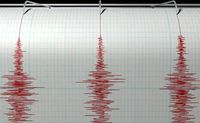A magnitude 6.9 earthquake struck off the coast of New Britain Island in Papua New Guinea on Saturday morning, April 6, 2025, at approximately 6:04 AM local time (20:04 GMT). The earthquake occurred at a depth of 10 kilometers and was centered about 194 kilometers southeast of the nearest city, Kimbe, according to the United States Geological Survey (USGS).
The tremor was significant enough to trigger immediate tsunami alerts, which were later lifted by the Pacific Tsunami Warning Center. Fortunately, no significant damage has been reported in the aftermath of the quake. Marolyn Simbiken, a receptionist at the Liamo Reef Resort in Kimbe, stated, "Yes, we felt the earthquake here... but there has been no major damage. Nothing was damaged here, and there was no evacuation." This sentiment was echoed by many locals who remained vigilant but unscathed.
Despite the lack of immediate destruction, the earthquake has heightened concerns about potential aftershocks, which were felt shortly after the main event with magnitudes ranging from 4.9 to 5.3. Emergency services have been placed on high alert, ready to respond should the situation escalate.
Papua New Guinea, located in the Pacific Ring of Fire, is no stranger to seismic activity. The region is characterized by frequent earthquakes due to the collision of tectonic plates. This latest event serves as a stark reminder of the ongoing risks faced by communities in this seismically active area.
In light of this earthquake, local authorities have emphasized the need for robust infrastructure capable of withstanding such natural disasters. Discussions are underway regarding the implementation of improved construction standards and community preparedness initiatives, which are critical for mitigating the impacts of future earthquakes.
The earthquake also raised alarms across the broader region, prompting tsunami alerts for several neighboring countries, including Indonesia, the Philippines, Australia, New Zealand, and the American islands of the Pacific. The alerts were particularly pertinent for northern Australia, where the tremor was felt with considerable intensity.
As the dust settles from this seismic event, the psychological effects on the local population are also being considered. Many residents have expressed concerns not just about the physical repercussions of the quake but also about the mental toll that such natural disasters can take. The uncertainty and fear associated with living in a seismically active zone create a challenging environment for families.
Historically, Papua New Guinea has experienced devastating earthquakes, with past events leading to significant loss of life and widespread destruction. The memory of these incidents lingers in the minds of many, reinforcing the importance of preparedness and resilience.
In the wake of the earthquake, scientists continue to monitor the region's seismic activity closely, providing vital analyses and forecasts that are essential for public safety. Their work not only aids in immediate response efforts but also contributes to long-term strategies aimed at reducing vulnerability to earthquakes.
The international community is also keeping a watchful eye on the situation, ready to offer support if necessary. The resilience of the people living in these earthquake-prone areas is commendable, and strengthening solidarity among communities during difficult times is crucial.
As the residents of Papua New Guinea navigate the aftermath of this earthquake, the focus remains on ensuring safety, enhancing infrastructure, and fostering preparedness to face the challenges posed by natural disasters. This event serves as a critical reminder of the power of nature and the need for continued vigilance in the face of such threats.
In summary, while the immediate effects of the magnitude 6.9 earthquake have not resulted in significant damage, the event has reignited discussions about the importance of earthquake preparedness and infrastructure resilience in Papua New Guinea. As communities remain on alert for potential aftershocks, the lessons learned from this event will undoubtedly shape future strategies for disaster response and community safety.






